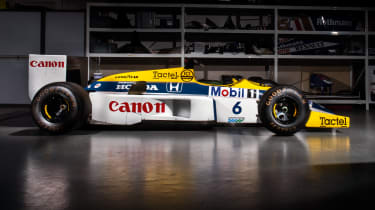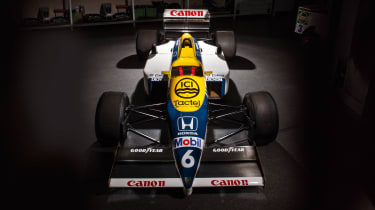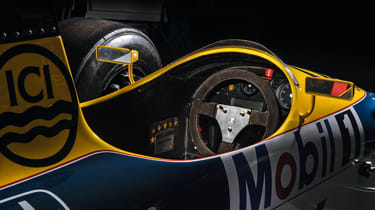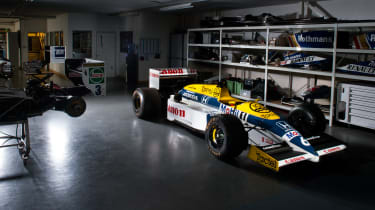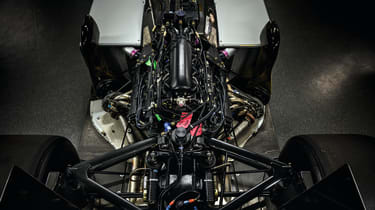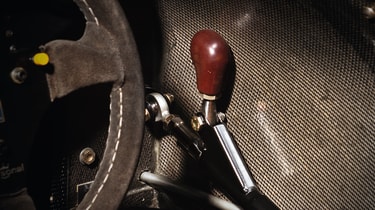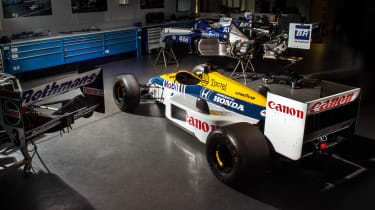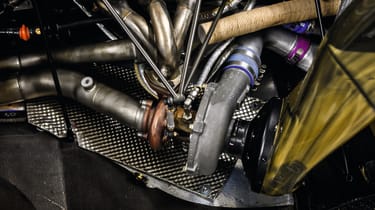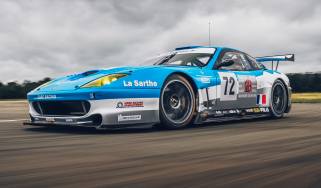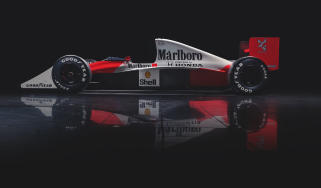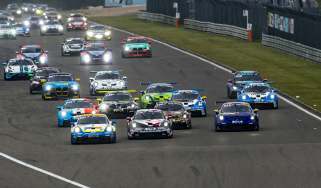Williams‑Honda FW11: the anatomy of a 1980s turbo F1 car
Formula 1 in the ’80s is remembered for the advent of turbochargers and ever‑increasing power figures, and one car more than any other typified the sport in that era – the Williams‑Honda FW11
It’s impossible not to admire Renault’s sheer chutzpah. When France’s national car company decided to go motor racing in the ’70s, it threw itself headlong into the new and mysterious world of turbocharging rather than taking the conventional route. It began publicly in sportscar racing during 1976, and its 2-litre, V6-powered home-grown prototype would score an emotional win at Le Mans in 1978, but in 1977, at the British Grand Prix, it started arguably an even bigger challenge: to win in Formula 1.
The Renault RS01, with its little 1.5-litre, iron-block, single-turbo EF1 V6, was a staggeringly bold entry, for not only was Renault taking up the 1.5-litre forced induction option ignored by all and sundry, it was also building its own chassis and running its own team in-house (no buying a British-based team wholesale here), with a patriotic ensemble that included Elf fuel, French drivers and Michelin tyres, the last of those introducing radial construction to F1.
> Ferrari 550 Maranello Prodrive: the anatomy of a Le Mans GT car
Many in F1 laughed when the RS01 first appeared. Ken Tyrrell called it a teapot because it frequently blew up in a cloud of white smoke. Turbo lag could be measured with a calendar, and the chassis, kept simple so there was less to worry about, was correspondingly unspectacular and overweight. The engine made around 500bhp: largely comparable with the outputs of the opposition’s 3-litre naturally aspirated V8s and V12s, but nowhere near enough to offset the disadvantages inherent to its design – yet.
The team scored its first points in 1978, and its first win in 1979 (with the twin-turbo RS10), and now nobody was laughing anymore. A naturally aspirated car won the world title for the last time for seven years in 1982, but only just, and from there on in a turbo engine was a must. Ferrari made the switch in 1981, BMW appeared during 1982, and Honda and TAG-Porsche, tentatively, part way through 1983. F1’s glorious, power-mad, excess-all-areas ’80s era was truly under way, lasting until the end of 1988 when the formula was outlawed for new regs with 3.5-litre naturally aspirated engines. Here we look at what made those larger-than-life turbo F1 cars what they were, with help from the ultimate of its type: the 1986 Williams-Honda FW11.
Williams-Honda FW11-05
It’s become fashionable to decree the 1988 McLaren-Honda MP4/4 as the ultimate ’80s turbo F1 car; some claim it the greatest of all time. The MP4/4 was a very special car, but one also neutered to a degree by rule changes (more later). If you view ‘ultimate’ as being about raw performance, beating the best teams at the height of their powers, and maintaining that success over two extraordinary seasons, then it has to be the blistering Williams-Honda FW11.
Williams was the form team going into the 1986 season, and as Jonathan Williams (son of founder Frank) says today: ‘Nelson [Piquet] joining Williams was a big step for the team. Before then our champions [Alan Jones, Keke Rosberg] had been home-grown, but Nelson was the first world champion that said, “I want to go to Williams,” just as Honda was the first manufacturer to go racing with Williams.’ Retained for ’86 was a Brit who’d finally made his mark after four years at Lotus: Nigel Mansell. Few expected the moustachioed Brummie to mount a challenge to then double world champ Piquet, but no one told Mansell that…
Chassis 05 – the car in these pictures – was Piquet’s car. He won three times with it – in Germany, Hungary and Italy. It was during the race near Budapest that Piquet executed arguably the most spectacular overtaking move of all time, given its audacity and the quality of opposition. Having already duelled with Ayrton Senna’s Lotus-Renault, Piquet finally made it stick by taking the young Brazilian round the outside at the first corner, while simultaneously on wild opposite lock and flipping the bird. Enough said.
That year Mansell was on course to be champion until his rear tyre blew at V-max in Adelaide. Most of the UK swore, and Alain Prost and McLaren snatched the drivers’ crown.
Body structure and aerodynamics
The early ’80s was the era of ground effect. Ushered into F1 for 1978 with the beautiful Lotus 79, sealing off the underside of the cars with skirts turned them into upside-down wings, sucked to the track, and made conventional surface wings all but redundant when ground effect was at its peak in 1982. The result was cornering speeds and forces so high drivers struggled to cope and safety was becoming an issue. Skirts were banned the following year, and the F1 car of 1983 looked completely different. Downforce was dramatically reduced, despite the advent of large, bookcase-like wings, and it would be 1987 before aero was back to 1982 levels. Nevertheless, ’80s turbo cars could afford to run huge wings with lots of drag, as they weren’t exactly short on power.
The other big advance of the turbo era was in chassis construction. A carbonfibre tub was first raced by McLaren in 1981 with the revolutionary MP4/1, but until the last races in 1983 that car had run with a Cosworth V8 in the back. Williams was late to adopt the technology, sticking to aluminium honeycomb, but by 1985 it too had a carbon tub, while a rear diffuser boosted in effectiveness by exhaust gases had already been pioneered by Renault. It would take a low-budget car from a new designer by the name of Adrian Newey to move aerodynamics on again, his 1988 March-Cosworth 881 a trendsetter for so much that followed.
Engine, electronics and gearbox
Prost and Renault should have scooped both titles in 1983, but it was not to be. In fact, Renault, after all the effort and innovation, never would win a turbo-era world championship.
The magic ingredient behind Piquet’s late-season surge that year in the Brabham-BMW was to prove one of the key elements of the turbo era: fuel. BMW had found a lot more power, all of a sudden, for its in-line four, and unlike Renault with its water injection it had done it via the Wintershall subsidiary of German chemical giant BASF. Wintershall had exploited a loophole in the rules that meant ‘petrol’ didn’t have to mean, er, petrol at all.
Toluene, a derivative of benzene, had been used in Luftwaffe fighters in World War II. By 1985, F1 cars ran on 80 per cent toluene mixed with 20 per cent further chemicals; it was evil, sweet-smelling stuff, brewed in labs under strict safety conditions and then decanted in the pits by mechanics in shirt sleeves (no wonder some would develop serious health problems in later life). F1 cars threw it into their engines in huge quantities. Look closely at footage of the time and you’ll see clouds of vapour and black-brown gases – unburnt hydrocarbons – trailing behind the cars, while drivers’ crash helmets wore a thick layer of brown grime at the end of a race.
The other key factor, over and above the extreme development of the turbos themselves, was in engine control electronics. When turbo engines first appeared they were mechanically fuel injected, but gradually the electronic control of an engine’s parameters became increasingly sophisticated. In 1983 an F1 car had 250 litres of fuel to complete a race, plus the option of mid-race refuelling. Consumption, therefore, was not such an issue, and an engine could be run rich to prevent detonation. However, that quota was reduced to 220 litres for the 1984/85 seasons (and refuelling banned), and 195 litres for 1986/87. Suddenly, simply throwing fuel at the problem would mean the car coasting to a halt a few laps from the end – as many did during the latter part of the turbo era. The best engine, then, was the one that could run reliably close to the point of detonation, using the least fuel while making the most power, and also offering (relatively) good driveability. One engine above all others cracked that magic formula…
Honda’s beginnings were somewhat inauspicious. The iron-block RA-163-E V6 was first seen in the fledgling Spirit Racing entry during 1983, Spirit and Honda having been an item in F2. Spirit’s results were far from awful on a tiny budget, but Honda, having desired a low-key start, was now after rapid progress, and signed a deal with Williams Grand Prix Engineering for the 1984 season.
That original 1984 Williams-Honda FW09 is infamous for its ludicrously intolerant nature. Outright power wasn’t an issue, with the 80-degree V6 spinning to 12,000rpm and already pushing 900bhp in qualifying. However, these early D-spec motors were chronically unreliable, with numerous piston failures and flexing of the block, while the crude IHI turbos gave the power delivery the immediacy of a light switch. Keke Rosberg and Jacques Laffite, both supremely talented and hard-as-nails veterans in the classic GP driver mould, were quoted as saying there was ‘wheelspin anywhere, in any gear at almost any speed’. Consider that the powerband was reportedly from 10,300 to 11,400rpm and Williams developed a six-speed ’box in a futile attempt to tame it; quite how any mere mortal could drive this 540kg projectile beggars belief.
That winter, Honda threw its whole technical R&D might behind the project. It’s often been said that F1 in this era for Honda was an engineering exercise, to develop new technologies and give engineers new experiences, rather than the purely marketing exercise F1 is today for all major manufacturers. The firm built an incredible 25 different engine configurations during testing, while Williams also moved up a gear, debuting in the chunky FW10 its first carbon tub chassis and iconic blue/white/yellow livery of its key sponsors. By mid-season there was an E-spec engine – a new, stiffer block with a smaller bore size, giving over 1000bhp in qualifying trim – and the FW10 took the final three races of the season, split between Rosberg and new recruit Mansell.
Which brings us to 1986 and the mighty FW11 and its RA‑166-E F-spec V6 – one of the all-time classic racing engines. All new, it featured car-to-pit telemetry (Honda had developed its own electronics from the start), and offered four power settings controlled by a simple switch on the amazingly primitive dashboard, ranging from ‘1’ being fuel save mode to ‘4’ being overtaking power (1000bhp). In qualifying it was supposedly good for 1300bhp, but then there was no dyno capable of measuring it, so that was an engineering-led guess. The BMW four-pot potentially had slightly more, the ultimate Renault and Porsche V6s slightly less, but no one could generate big power and be so frugal as the Honda, and that was the clear advantage. There were no driver aids, and a straightforward six-speed manual ’box with a limited-slip differential. It was quite simply man and machine locked in battle.
Suspension, tyres and brakes
After successive breakthroughs in the previous decade, the running gear of F1 cars in the turbo era took a back seat to outright horsepower, as did innovation in aerodynamics. As mentioned, Michelin debuted radial tyre technology with Renault in 1977, and stayed until 1984, whereupon Goodyear moved to radials and became the leading supplier, with Pirelli the outsider, sometimes giving teams such as Benetton an edge on a given day and in certain conditions. Special one-lap sticky qualifying tyres and limitless amounts of race tyres per weekend were all part of the game…
Suspension design, too, was more conventional, following the adjustable ride-height trickery of Gordon Murray’s Brabhams at the start of the decade. Pushrod or pullrod front suspension became the norm, and it was only in 1987 that more daring approaches started to be made. Lotus introduced the active suspension 99T, which used a primitive computer to offer full active ride; Senna won at both Detroit and Monaco, the system proving a significant advantage on street circuits. Williams had its own self-levelling suspension set-up for the FW11B, with Piquet undertaking all the testing for the team. He then used it to win the Italian Grand Prix, proving the system’s worth, but it wouldn’t be until 1992 that Williams fielded a car with fully active suspension. The FW11 was also the first Williams to run with carbon-carbon brakes, the technology having first appeared at the end of the ’70s and pretty much de rigueur by the mid-’80s.
Driving a 1980s F1 turbo car
Derek Warwick was a household F1 name throughout the ’80s and into the ’90s, and much of that was spent at the wheel of turbocharged cars from Toleman (1981-83), Renault (1984-85), Brabham-BMW (1986) and finally Arrows-Megatron (privately run BMW engines; 1987-1988).
In 1981 Toleman partnered with British engine builder Brian Hart to go down the turbo route. But Hart’s resultant 415T engine had a difficult gestation. ‘It was a disaster,’ recounts Warwick today. ‘The turbo was on the back of the gearbox, the lag measured in minutes. You learned very quickly how to left-foot brake, and if you were braking for the back chicane at say, Zolder, you’d go in braking as hard as you could, at the same time keeping the throttle down, and it’d be 50 yards after the corner that the turbo would kick in. It was extreme lag, but got a bit better in 1982, and much better in 1983, which was a much improved engine with more development.
‘They were different cars to drive. If you got on to the turbo too quickly you’d understeer off, if you got on it too late you’d spin the back wheels up, so there was a knack to it. You had to blip the throttle a lot to keep the turbo spinning, and do a lot of left-foot braking. You were always protecting the rear of the car – gearbox, diff, tyres – because the power came in like a light switch, it wasn’t regulated.
‘When I moved to Renault the engine was beautiful – a lot easier to drive [but now with up to 1000bhp in qualifying]. We also had a push-to-pass button which gave us more boost. You were driving these cars around Monaco basically one-handed [the other constantly changing gear in a manual ’box] with power that was ridiculous. As a driver – and it might sound strange – but it put a smile on your face. It was such a challenge to do a qualifying lap.
‘Then after Elio de Angelis’s death in 1986 [during a test at Paul Ricard] I joined Brabham for the rest of the season, and that was another experience, because it was an awful car but with a works BMW engine and I’d never felt power like it. You could never practise a [qualifying] lap because the engines were like light bulbs – you’d put it in for qualifying, do your run and then unplug it and throw it in the bin after 30km. There were no wastegates, just blanking plates. At Monza we had something like 1350bhp – unbelievable.
‘The BMW had more lag than the Renault, but more power. You could not change gear fast enough. I remember at Monza going up 2000 revs on every gear [ratio] thinking that was enough [for qualifying] and reaching the end of the pit exit on my flying lap and already being on the limiter and having to feather the throttle halfway down the straight. [Gerhard Berger’s 219mph that day in a similarly powered Benetton-BMW was an F1 record for many years.] I was going all around the lap with a silly smile on my face, thinking this is absolutely amazing. It wasn’t agricultural, but it was a rough engine, and not a driveable one; it was very difficult.’
Postscript
Williams updated the FW11 into ‘B’ configuration for the 1987 season, and Honda followed suit, setting up base in Slough outside the Williams factory as it was now also supplying Lotus. New for ’87 was an FIA boost limit of 4bar, achieved by mounting a so-called ‘pop-off’ valve next to the turbo. Nevertheless, with improved electronic control and higher compression, the G-spec RA-166-E probably raced with more power than it did the previous year – a minimum of nearly 1000bhp. The ’87 cars were the lightest of the turbo era, with a minimum weight of 500kg, while the fuel allowance stayed at 195 litres. The FW11B reclined the driver a little further and featured slightly revised aerodynamics. Not only did Williams win the constructors’ title again, this time there was no denying it a drivers’ title, with Piquet, an injured Mansell having fallen from contention following an accident at Suzuka. Honda, not happy with a number of Williams’ management decisions, signed with McLaren and Lotus for 1988, and promptly removed every last engine and piece of technical IP from Williams’ HQ, zealously protecting its secrets.
When the FIA announced turbo engines would be outlawed in F1 from the 1989 season, it laid the groundwork for naturally aspirated power by significantly reining in the turbo engines for their final year in 1988. It was hoped the 3.5-litre NA engines, such as the Ford Cosworth V8 and Judd V8, would be able to realistically compete against turbo units from Honda and Ferrari. Maximum boost was reduced to just 2.5bar, while the fuel limit shrank further to only 150 litres. That meant cars such as the McLaren-Honda MP4/4 and the Ferrari F1-87/88 were racing with ‘just’ 600-640bhp, a far cry from the heady days of 5bar madness a couple of years previously.
Only Honda went to the trouble and expense of building a new 1.5-litre turbo for just one season – the RA-168-E. So equipped, they smashed the opposition, winning 15 out of 16 races, and only losing at Monza when Senna was taken out by the Williams of Jean-Louis Schlesser, standing in for Mansell, near the end of the race. Ferrari scored a one-two that day; its updated 1987 car was equally as fast as the McLaren in a straight line, but was horrendously thirsty in comparison to the Honda. It never stood a chance on race day.
Turbo engines wouldn’t return to F1 until 2014, in 1.6-litre V6 form. With the benefit of an additional electrical boost, these engines are now producing over 1000bhp, rivalling the ’80s monsters for outright power but with immeasurably better driveability, fuel consumption and reliability, and no five-speed H-pattern manual gearbox to grapple with. Having said that, they are also around 200kg heavier…
Running a Williams-Honda FW11 today
Although you won’t find an advert anywhere, FW11-05 is technically for sale. You’ll need around £2.5million, but in reality, that’s just the start of your commitment; not necessarily a financial one, although clearly this is far from an ‘affordable’ car to run, but more that owning it requires the right attitude. Tom Morton, team manager at Williams Heritage, views the most important part of his role as protecting Williams’ illustrious history. In short, you have to be the right fit.
For years, the team’s FW11s were without engines, those having disappeared when the team split with Honda at the end of 1987. However, in 1999 a request was made to Honda and a few months later, incredibly, four fully prepared engines arrived from Japan. FW11-05 has one of those engines. ‘If I owned that car I wouldn’t want to run it,’ says Morton. ‘I imagine I’d buy it, run it once, then have it in my house. Protecting that engine is very important – without it it’s worth a lot less.’ That’s even before the thought of stuffing it into a wall and destroying a piece of racing history. Realistically, a safe rev cap of 9500rpm and 1.5bar boost might give 550bhp (still 1000bhp-per-ton!), but it’s worth remembering how thin and light these monocoques were, and how far forward your feet are in the chassis…
This story was first featured in evo issue 274.

